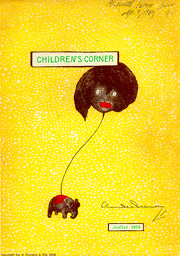
|
Golliwogg.co.uk |
Golliwogg.co.uk
|
|||||||
|
"Children's Corner"
Suite |
|||||||
The title of the first alludes to Muzio Clementi's collection of instructional piano pieces, Gradus ad Parnassum. The most familiar piece is the last, Golliwogg's Cake-Walk. The middle section of this cake-walk (is jokingly interrupted on several occasions by quotations of the opening of Richard Wagner's opera Tristan und Isolde, marked "avec une grande émotion" (with great feeling). Each quotation is followed by a sort of musical chuckle in staccato chords: 
Children's Corner was published by Durand in 1908, and was given its world premiere in Paris by Harold Bauer on December 18 of that year. In 1911 an orchestration of the work by André Caplet received its premiere (on March 25) and subsequently published. A typical performance of the suite will last around 15 minutes. * A Cake-walk is a traditional African American form of music and dance which originated among slaves in the US South. A cake, or slices of cake, were offered as prizes for the best dancers - a rare treat during slavery - giving the dance its name. The syncopated music of the cake-walk became a nationally popular force in mainstream music of the USA late in the century, and with growing complexity and sophistication evolved into ragtime music in the mid 1890s. The term "cake-walk" is often used to indicate something that is very easy or effortless. Though the dance itself could be physically demanding, it was generally considered a fun, recreational pastime. |
|||||||
